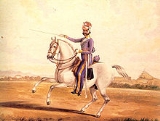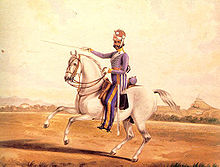
16th Light Cavalry
Encyclopedia

Indian Army Armoured Corps
The Indian Army Armoured Corps is one of the combat arms of the Indian Army. Formed in 1947 from two-thirds of the personnel and assets of the Raj's Indian Armoured Corps. It currently consists of 63 armoured regiments, including the president's bodyguards. The naming of the regiments varies...
, a primary combat arm of the Indian Army
Indian Army
The Indian Army is the land based branch and the largest component of the Indian Armed Forces. With about 1,100,000 soldiers in active service and about 1,150,000 reserve troops, the Indian Army is the world's largest standing volunteer army...
. Prior to India gaining independence from the British in 1947, it was a regular cavalry regiment of the British Indian Army
British Indian Army
The British Indian Army, officially simply the Indian Army, was the principal army of the British Raj in India before the partition of India in 1947...
. It was formed in 1776 and saw service in a number of conflicts ranging from the Second Anglo-Mysore War
Second Anglo-Mysore War
The Second Anglo-Mysore War was a conflict in Mughal India between the Sultanate of Mysore and the British East India Company. At the time, Mysore was a key French ally in India, and the Franco-British conflict raging on account of the American Revolutionary War helped spark Anglo-Mysorean...
in 1781 to World War II
World War II
World War II, or the Second World War , was a global conflict lasting from 1939 to 1945, involving most of the world's nations—including all of the great powers—eventually forming two opposing military alliances: the Allies and the Axis...
.
Formation
The Regiment was raised prior to 1776 as the 3rd Regiment of Native Cavalry in the service of Nawab of Arcot. In 1780, while under service with the British East India CompanyBritish East India Company
The East India Company was an early English joint-stock company that was formed initially for pursuing trade with the East Indies, but that ended up trading mainly with the Indian subcontinent and China...
, it formed part of the force that defeated Hyder Ali
Hyder Ali
Hyder Ali was the de facto ruler of the Kingdom of Mysore in southern India. Born Hyder Naik, he distinguished himself militarily, eventually drawing the attention of Mysore's rulers...
during the Second Anglo-Mysore War
Second Anglo-Mysore War
The Second Anglo-Mysore War was a conflict in Mughal India between the Sultanate of Mysore and the British East India Company. At the time, Mysore was a key French ally in India, and the Franco-British conflict raging on account of the American Revolutionary War helped spark Anglo-Mysorean...
and was awarded battle honours for the Battle of Sholinghur
Battle of Sholinghur
The Battle of Sholinghur was fought on 27 September 1781 between forces of the Kingdom of Mysore led by Hyder Ali and British East India Company forces led by General Eyre Coote. The company forces were victorious.-References:*Vibart, H. M ....
, Battle of Mysore, Battle of Carnatic and the Battle of Seringapatam
Battle of Seringapatam
The Siege of Seringapatam was the final confrontation of the Fourth Anglo-Mysore War between the British East India Company and the Kingdom of Mysore. The British achieved a decisive victory after breaching the walls of the fortress at Seringapatam and storming the citadel. Tippu Sultan, Mysore's...
for service during the Anglo-Mysore Wars.
After the Anglo-Mysore Wars the Regiment was next in action during the Third Anglo-Burmese War
Third Anglo-Burmese War
The Third Anglo-Burmese War was a conflict that took place during 7–29 November 1885, with sporadic resistance and insurgency continuing into 1887. It was the final of three wars fought in the 19th century between the Burmese and the British...
and were awarded the Battle Honour of Burma 1885-87.
Early 20th Century
During World War IWorld War I
World War I , which was predominantly called the World War or the Great War from its occurrence until 1939, and the First World War or World War I thereafter, was a major war centred in Europe that began on 28 July 1914 and lasted until 11 November 1918...
(1914–1918) the regiment remained in India for the defence of the North West Frontier but they did send drafts to other Indian cavalry regiments serving in France
France
The French Republic , The French Republic , The French Republic , (commonly known as France , is a unitary semi-presidential republic in Western Europe with several overseas territories and islands located on other continents and in the Indian, Pacific, and Atlantic oceans. Metropolitan France...
and the Middle East
Middle East
The Middle East is a region that encompasses Western Asia and Northern Africa. It is often used as a synonym for Near East, in opposition to Far East...
. In 1919 the regiment was involved in the brief Third Afghan War, for which they were awarded the battle honour of Afghanistan 1919.
World War II
During World War IIWorld War II
World War II, or the Second World War , was a global conflict lasting from 1939 to 1945, involving most of the world's nations—including all of the great powers—eventually forming two opposing military alliances: the Allies and the Axis...
the regiment was employed in the defence of India having converted from horses to armour at Quetta
Quetta
is the largest city and the provincial capital of the Balochistan Province of Pakistan. Known as the "Fruit Garden of Pakistan" due to the diversity of its plant and animal wildlife, Quetta is home to the Hazarganji Chiltan National Park, which contains some of the rarest species of wildlife in the...
in 1941.
In 1945 they were selected to undertake operations in Burma. Within three weeks the Regiment covered a distance of 3,500 miles from Quetta to the banks of Irrawady River
Ayeyarwady River
The Irrawaddy River or Ayeyarwady River is a river that flows from north to south through Burma . It is the country's largest river and most important commercial waterway. Originating from the confluence of the N'mai and Mali rivers, it flows relatively straight North-South before emptying through...
and was personally complimented by General Slim, the Fourteenth Army
Fourteenth Army
A number of nations have had a Fourteenth Army:* Fourteenth Army * Fourteenth Army * Italian Fourteenth Army* Fourteenth United States Army, a World War II 'phantom' force...
commander.
In Burma the regiment was attached to the 255th Indian Tank Brigade
255th Indian Tank Brigade
The 255th Indian Tank Brigade was an armoured brigade of the Indian Army during World War II. It was part of the Fourteenth Army and saw action in the Burma Campaign...
, the brigade formation was;
-
- 116 Royal Armoured Corps (Sherman tanks), formed from the Gordon Highlanders
- 7th Light Cavalry7th Light CavalryThe 7th Light Cavalry, was a regular army cavalry regiment in the British Indian Army which first came into British service with the East India Company and went on to serve on the North West Frontier and in World War I and World War II.-Formation:...
(Stuarts) - 16th Light Cavalry (Armoured Cars).
Lineage
- 1776 – Regiment of Cavalry (Stevenson's), Nawab of Arcot's Army
- 1784 – 3rd Madras Native Cavalry
- 1784 – 1st Madras Native Cavalry
- 1786 – 4th Madras Native Cavalry
- 1788 – 2nd Madras Native Cavalry
- 1819 – 2nd Madras Light Cavalry
- 1886 – 2nd Regiment of Madras Lancers
- 1901 – 2nd Madras Lancers
- 1903 – 27th Light Cavalry
- 1922 – 16th Light Cavalry
- 1947 – Allocated to India at independence and partition, continues in service as 16th Light Cavalry
External links
- Uniforms of the late 19th Century
- http://16cavroa.com/
- http://www.wolftree.freeserve.co.uk/Burma/Burma.html

